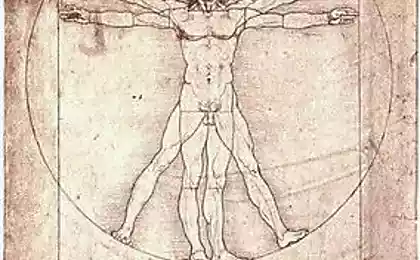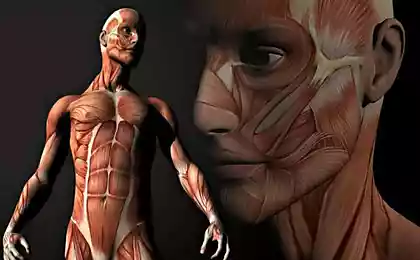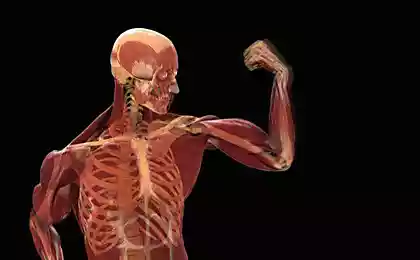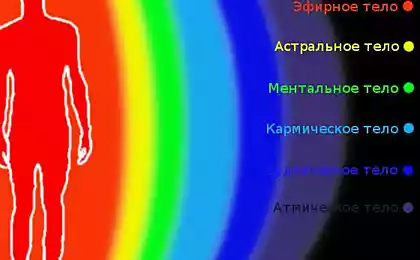1106
37 facts about our body

The Greek philosopher Aristotle believed that the brain exists, mainly to cool the fluid within the body. Currently, it is known that the brain controls almost all functions of the body and mind.
In an average adult skin is about 12-20 square meters, weight is about 12% of body weight.
In the human body is more than 600 individual skeletal muscle.
The skeleton of the adult human body consists of 213 bones.
Cartilage is one of the few types of tissue that grows throughout life. At the age of 30 to 70 years, the nose may grow by 1, 2 centimeters, and the ears of 6 millimeters.
Skull of a newborn contains a space between the bone plates. In adults, the toothed plates are closed tightly, as in the children's game puzzles.
Ordinary human head covers about 100,000 hair.
With age, the diameter of each hair on the head is reduced. Hair reach its peak volume to 20 years, and only 70 are as thin as a baby. Aging also stimulates the growth of hair in areas where they should not be, for example, in the nose and ears, and also causes the drop where it is needed.
Hundreds of billions of neurons to conduct electrical signals that control the body, from the brain and spinal cord.
After some brain diseases, such as trauma, stroke or infection, some people develop "alien hand syndrome," a condition in which the sick can feel his hand, but has no control over the movement and did not feel his hand as a part of his body. < br /> When the pituitary gland loses its basic function, it can increase or decrease the amount of growth hormone in the body of a growing child, which results in gigantism or dwarfism.
Emotion is very suited to our world, but they have limitations. For example, people can not see in the ultraviolet spectrum, as do bees, and can not differentiate between millions of smells than have a bloodhound.
Appendicitis has no role in the life of modern people organisms. It is believed that he was part of the digestive system in our primitive ancestors. Outdated information plays.
Odor in humans is defined as "stereo". That is, the different signals from the nostrils from a variety of odors coming into certain areas of the brain. It can help a person to determine the direction from which the odor.
The skin contains sensory receptors 640,000 scattered unevenly across the surface of the body. These receptors are found in higher concentrations in the ranges of hands, lips, on the tongue, the palms, the soles of the feet and the genitals.
Five million olfactory receptors in the upper part of our nasal passages are grouped into the membrane. These receptors help us to distinguish thousands of unique flavors.
There are about 9000 receptors on the surface of the tongue, throat and palate.
Over a lifetime, men produce about 10 000 liters of saliva. It is necessary for taste, the food is not dissolved by saliva, we can not fully enjoy all the taste qualities.
The human ear - less keen senses in humans, compared to the many animals that can detect sounds in a much more high and low frequencies, as opposed to us.
With the maturation of the lens becomes more dense. That's why people who've seen the great, often need glasses in the 40 years.
The body of an adult human consists of about 100 trillion cells.
The body transports about 25 trillion red blood cells (RBCs), the most important cells in our body. Red blood cells make up about 45% of the total blood volume.
Every hour, formed about 180 million new erythrocytes. Prior to the release from the bone marrow, most of the red blood cells are converted into disk-shaped balloons, which are ideal for the transport of oxygen and a small amount of carbon dioxide throughout the body.
White blood cells, or white blood cells make up about 1% of the total amount of blood. It may be that their number will double during the day, but it is only when the body reacts to infection.
The circulatory system of arteries, veins and capillaries is about 60 000 kilometers.
The heart beats more than 2, 5 billion times in a lifetime (referring to the average duration of human life).
Unlike other muscles, the heart muscle goes without incentives from the nervous system. The signal for the heart to beat comes from the sinoatrial node at the top of the right atrium.
In healthy adults, the length of the small intestine ranges from 5: 5 to 7 meters, which is about four times greater than the height of the person. About 90% of the nutrients absorbed into the bloodstream in the small intestine.
About semi- meters in length, the colon is much shorter than the small intestine. The space it more spacious, which allows you to cut and use in the operations of certain parts of the body.
There are about 120 meters of seed tubes in the scrotum human male. At this point, the sperm stored before ejaculation and released in an amount of 200 to 500 million sperm cells, each capable of fertilizing an egg.
During ovulation, the number of white blood cells in the cervix drops sharply. If this does not happen, the white blood cells to destroy all foreign bodies, including sperm.
Unlike other cells that contain the total DNA of human sperm and ovum include only half of the DNA necessary to create a new person. Both halves must be connected, otherwise just does not happen breeding process.
Proper nutrition is very important for brain development in the child. The brain of children who died of malnutrition during the first year of life, has a much smaller cell size, and smaller than the brain of a healthy child.
DNA - is a basic "building block" of life, representing a long molecules that contain four chemical components: adenine (A), guanine (G), thymine (T) and cytosine ©.
The human genome in half a DNA core contains about 31 billion pairs of bases: A, G, T and C.
The maximum life span of a mammal, usually corresponds to their size. The duration of human life should be somewhere between goats and horses, between 10 and 30 years. But, as the development, people developed new ways of protection from predators and disease, thereby increasing their life expectancy up to 74, 7 years (in the US).
























